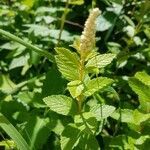Shrubs, 3–15 dm. Stems erect to ascending, rarely branched. Leaves: petiole 2–3 mm; blade ?bicolorous?, ovate-lanceolate, 3–6 × 1–2.5 cm, coriaceous, base cuneate, margins coarsely serrate to crenate on distal 3/4, (secondary teeth on large and long shoot leaves), venation pinnate craspedodromous, secondary veins prominent, apex acute or rounded, abaxial surface densely ?white to gray, tan, or rusty?, tomentose, adaxial glabrous or puberulent. Inflorescences predominantly terminal, narrow, conic panicles, ?150–15,000+-flowered?, 5–30 × 3–20 cm, ?branching varying from compact to wide and spreading?; branches tomentose. Pedicels 0.1–1.5 mm, tomentose. Flowers 4–6 mm diam.; hypanthia hemispheric, 0.5–1 mm, abaxial surface tomentose, adaxial glabrous; sepals triangular, 0.7–1.1 mm; petals usually light to dark pink, sometimes white or purple, ovate to orbiculate, 1–1.5 mm; staminodes 0; stamens 15–20, 1 times petal length. Follicles cymbiform, 2–2.5 mm, tomentose to arachnoid. 2n = 24, 36.
More
Simple or sparsely branched shrub to 12 dm; lvs ovate to oblong or lanceolate, 3–5 cm, beneath white or rufous with a dense tomentum and prominently veined; infl terminal, branched, elongate, 5–15 cm; hypanthium tomentose; sep reflexed after anthesis; fls pink or rarely white, 3–4 mm wide; fr pubescent; 2n=24. Swamps and wet meadows; N.S. and N.B. to Que. and Minn., s. to N.C., Tenn., and Ark. July–Sept. Var. tomentosa, chiefly eastern, has 11–20 fls per cm of axis; the ill-defined, mostly western var. rosea (Raf.) Fernald has 6–10 fls per cm of axis.
Fields and pastures in N. America. Swamps and low ground. Wetlands, woodland borders with moist acidic soil; at elevations up to 1,500 metres.






